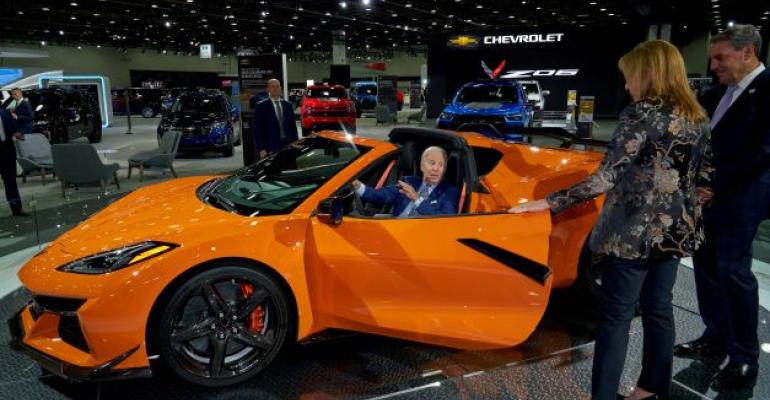DETROIT – President Biden appears at the North American International Auto Show to announce approval of an initial $900 million investment in electric-vehicle charging that is part of a total $5 billion investment included in the $1 trillion infrastructure bill signed into law last November.
The first wave of EV charger installation is aimed at putting fast chargers no farther apart than every 50 miles (80 km) in the federal highway system. Each new installation will have at least four charging ports capable of charging four vehicles at a time at 150 kW.
Biden, whose approval ratings have been languishing amidst inflation, high gas prices and new-car prices that have reached $48,000 on average, toured the show exhibits Wednesday at Huntington Place, flanked by Congressional Democrats from Michigan facing re-election this November.
“Charging stations will be up and as easy to find as gas stations are now," Biden says.
The $900 million investment will be channeled to 35 states and 53,000 miles (85,292 km) of interstate highways and is designed to eliminate so-called EV charging deserts and pepper the interstate highway system with fast-charging stations. Automakers and other proponents of accelerating EV adoption say that a leading impediment to buying an EV among consumers is fear of running out of power with no convenient fast chargers available.

Biden in Cadillac Lyriq BEV at North American International Auto Show in Detroit.
The many “big forces” at work to accelerate the mass adoption of electric vehicles are historic. Rising interest rates, high gas prices, rebates and incentives, historic regulation and massive infrastructure investments are all conflating to accelerate the biggest shift in consumer behavior in human history, says Scott Painter, CEO of California EV firm Autonomy.
“Every few years, EV adoption studies show that price is the number-one obstacle to buying an EV, but a close second is range anxiety and charging time, so the federal plan is going to very important in achieving the comfort and convenience level that consumers are demanding,” says Michele Krebs, senior analyst, Cox Automotive.
The other issue hamstringing EV adoption is an alarming rate of disrepair of EV chargers. The federal program addresses this by requiring states, if they want investment to keep flowing, to achieve a 97% rate of at least one charger per station working at all times.
The number of installed DC fast chargers (ports) grew to almost 22,000 at the end of 2021, up from 17,460 on December 31, 2020, according to evadoption.com.
After the initial $5 billion investment is launched, there will be an additional $2.5 billion in grants available for states to build chargers in rural and other underserved areas.
This EV charger investment prioritizes U.S. production of chargers, which has spurred foreign-owned manufacturers to set up shop stateside. Tritium, an Australian firm that supplies fast chargers to Chargepoint, is building a factory in Tennessee that will provide 30,000 fast chargers a year. And Siemens is expanding its manufacturing in the U.S to produce 1 million fast chargers per year.
Biden a Frequent Guest in Michigan
Biden has visited the Detroit area several times during his 21 months in office, including taking test drives of the Ford Lightning battery-electric pickup and the Chevy Silverado EV.
The president, facing stiff headwinds in the November midterm elections, is out to shore up support for Michigan’s Congressional Democrats. The state’s House delegation is divided equally between seven Democrats and seven Republicans, though both senators and Gov. Gretchen Whitmer – also up for re-election – are Democrats.
The Biden Admin. has restored momentum around transitioning the auto industry from internal-combustion engines to electric which was derailed during the previous administration.
- The recently signed Inflation Reduction Act provides $7,500 EV credits rebates for many buyers, though it is income-limited, and for many, but not all, EVs.
- The U.S. is back in the Paris climate accord and hosted a Global Leaders Climate Summit.
- The U.S. played a leading role at the COP-26 climate summit in Glasgow, Scotland, where Biden pledged the U.S. would reduce greenhouse-gas emissions at least 50% below 2005 levels by the end of the decade.
- Biden signed executive orders last year setting the goal of having zero-emission vehicles account for half of all U.S. light-vehicle sales by 2030 and committing the federal government to procuring only zero-emission light vehicles by 2035.
- Last month, Biden signed the CHIPS and Science Act, providing almost $60 billion to boost U.S. semiconductor production, including dedicated funding for microchips used by the auto industry. The industry has been beset for two years by a shortage of semiconductors, some 75% of which come from East Asia, because of production cutbacks during the Covid-19 pandemic and a major 2021 fire at the Renesas plant in Japan. The chip shortage cost the auto industry $210 billion in revenues and 7.7 million vehicles in 2021, according to AlixPartners.
Biden also talked up an increase in EV purchases by the federal government. In 2020, less than 1% of new federal vehicle purchases were electric, but that more than doubled in 2021 and 2022. Federal agencies acquired five times as many EVs in the last fiscal year compared with the year before, according to the White House.
Biden signed an executive order in December directing the government to purchase nearly all EV or plug-in hybrid-electric models by 2027. The U.S. government owns more than 650,000 vehicles and purchases about 50,000 vehicles annually.





